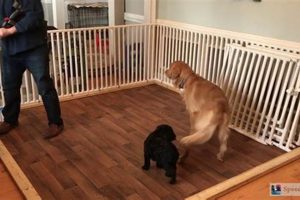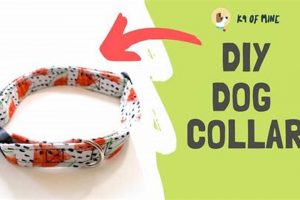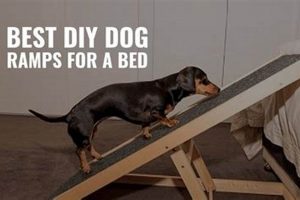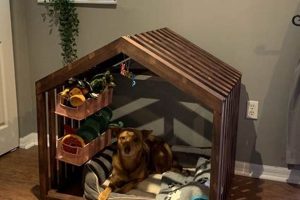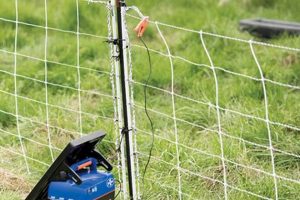The construction of elevated feeding platforms for canines, often undertaken as a do-it-yourself project, addresses the ergonomic needs of pets during meal consumption. These customized structures serve to raise food and water receptacles off the ground, offering a more accessible and comfortable eating posture for dogs. For instance, an individual might construct such a platform using wood and basic tools to create a stand that accommodates standard-sized bowls.
The primary benefit of elevated feeding platforms lies in their potential to reduce strain on a dog’s neck and joints, particularly advantageous for larger breeds or those with mobility issues. Historically, such accommodations were not commonplace, but veterinary and canine health experts have increasingly emphasized the positive impact of improved feeding posture on digestion and overall well-being. This shift in understanding has fueled interest in creating custom solutions for individual canine needs.
The subsequent sections will detail the practical aspects of creating these structures, including design considerations, material selection, and step-by-step construction methods. This will provide a comprehensive guide for individuals interested in crafting a suitable feeding solution for their canine companions.
Construction Guidance
The following guidance provides practical considerations for the successful assembly of elevated feeding platforms. Adherence to these points will contribute to a durable, functional, and aesthetically pleasing outcome.
Tip 1: Material Selection: Prioritize durable, non-toxic materials for all components. Wood is a common choice, but ensure it is sealed with a food-safe finish to prevent moisture absorption and bacterial growth. Metal frames should be rust-resistant. Plastic alternatives should be BPA-free and designed for food contact.
Tip 2: Precise Measurement: Accurately measure the height of the dog’s shoulder while standing. The top of the bowl should be level with, or slightly below, the dog’s sternum to promote optimal posture. The diameter of the bowls also needs accurate measurement to hold bowls firmly without risking slipping.
Tip 3: Stable Base: Design a wide and stable base to prevent tipping, especially for larger breeds. Consider adding non-slip feet or a weighted base to enhance stability. Consider the eating habits of the dog. Some eat aggressively, so it must be stable.
Tip 4: Secure Bowl Placement: Implement a secure mechanism to hold the bowls in place, such as recessed openings or bowl rims that fit snugly within the stand. This prevents the bowls from sliding or being easily dislodged during feeding.
Tip 5: Smooth Edges and Surfaces: Ensure all edges and surfaces are smooth and free of splinters or sharp points to prevent injury to the animal. Sanding and sealing are crucial steps in wood construction.
Tip 6: Consider Cleanability: Design the stand with ease of cleaning in mind. A smooth, sealed surface can be easily wiped down. Avoid intricate designs that trap food debris. You might consider removable bowl holders.
Tip 7: Ventilation (Optional): If the stand encloses the bowls, ensure adequate ventilation to prevent moisture buildup and mold growth. This is especially important in humid environments.
A well-executed elevated feeding platform enhances the feeding experience for canines, promotes better posture and digestion, and demonstrates attention to detail in pet care.
The ensuing section will address frequently asked questions regarding construction techniques and design choices.
1. Ergonomic Height
Ergonomic height, in the context of canine feeding platforms, refers to the optimal elevation of food and water bowls to promote comfortable and healthy eating postures. This factor is a primary consideration in the design and construction of elevated feeding platforms. Its relevance stems from the direct impact on a dog’s musculoskeletal system and digestive processes.
- Shoulder Height Alignment
The top of the bowl should ideally align with the dog’s shoulder, or sit slightly below the sternum. This alignment reduces strain on the neck and back, allowing for a more natural eating position. Insufficient height forces the dog to lower its head excessively, while excessive height requires the dog to reach upwards, both potentially causing discomfort or long-term skeletal issues.
- Breed-Specific Considerations
Optimal feeding height varies significantly based on breed and individual size. A Great Dane requires a substantially taller stand than a Dachshund. Accurate measurement of the dog’s shoulder height is therefore essential before constructing a feeding platform. Pre-made stands often offer adjustable height features to accommodate varying dog sizes.
- Impact on Digestion
Maintaining proper posture during feeding can positively influence digestion. An elevated position may reduce the likelihood of esophageal distension and regurgitation, especially in breeds prone to these conditions. While not a guaranteed solution, ergonomically correct height contributes to a more comfortable and efficient digestive process.
- Adaptation for Senior Dogs
Older dogs often experience arthritis or other joint-related issues that make bending or lowering their head uncomfortable. Elevated feeding platforms can alleviate this discomfort and allow senior dogs to maintain independence during mealtime. Adjusting the height as needed to accommodate age-related changes is crucial for geriatric canines.
The facets above underscore the direct connection between ergonomic height and the functional value of a elevated feeding platform. Careful attention to this aspect ensures that the constructed feeding platform genuinely benefits the canine, improving comfort, posture, and potentially digestive health. Failure to prioritize correct height may negate the intended advantages, rendering the constructed stand ineffective or even detrimental.
2. Material Safety
The selection of materials for a canine feeding platform significantly impacts the health and well-being of the animal. In the context of do-it-yourself construction, the onus falls upon the individual to ensure all components are non-toxic and food-safe. The consequence of using inappropriate materials can range from mild allergic reactions to severe health complications, including poisoning. For instance, untreated wood can harbor bacteria, while certain paints and finishes contain volatile organic compounds (VOCs) that are harmful upon ingestion.
The practical significance of material safety extends beyond the immediate health risks. Durable and food-grade materials contribute to the longevity of the feeding platform. For example, stainless steel bowls are resistant to corrosion and bacterial growth, making them a preferable choice over plastic alternatives that can degrade over time and leach harmful chemicals. Similarly, sealing wooden structures with a non-toxic, waterproof sealant prevents moisture absorption and reduces the risk of microbial contamination. The implementation of such measures necessitates a thorough understanding of material properties and their potential effects on canine health.
In summary, material safety is a non-negotiable aspect of elevated feeding platform construction. The conscientious selection of non-toxic, durable, and food-safe materials safeguards the health of the animal and ensures the longevity of the structure. Disregarding this principle poses significant risks and undermines the intended benefits of providing an elevated feeding solution. Adherence to established safety standards and informed decision-making are crucial for responsible pet ownership and successful project completion.
3. Structural Stability
Structural stability represents a fundamental design requirement for any elevated feeding platform. The term denotes the capacity of the assembled structure to withstand anticipated forces without collapsing, tipping, or otherwise failing. The ramifications of inadequate stability extend beyond inconvenience; instability poses a potential hazard to the animal, potentially causing injury or inhibiting its ability to feed properly.
- Base Dimensions and Geometry
The base of the feeding platform must be sufficiently wide and geometrically configured to provide a stable foundation. A narrow or top-heavy design is inherently unstable, particularly when subjected to the dynamic forces of a dog eating or leaning against it. The footprint of the base should be proportionally related to the height and weight of the bowls it supports. For instance, a taller platform necessitates a broader base to maintain equilibrium.
- Material Strength and Rigidity
The materials used in construction must possess adequate strength and rigidity to resist bending, buckling, or fracturing under load. Softwoods, while often easier to work with, may lack the necessary load-bearing capacity for larger breeds or heavier bowls. Metal or reinforced composites offer superior strength, but require different fabrication techniques. The selected material should be appropriate for the size and anticipated use of the platform.
- Joint Integrity and Fastener Selection
The joints connecting the various components of the feeding platform represent critical points of potential failure. Properly designed and executed joints, secured with appropriate fasteners (screws, bolts, adhesives), are essential for maintaining structural integrity. Weak or poorly fastened joints can loosen or separate over time, compromising the stability of the entire structure. Selection of the proper fasteners, appropriate for the materials being joined, is essential.
- Load Distribution and Center of Gravity
The design should consider how the weight of the bowls and the dog’s interaction with the platform are distributed. A well-designed platform distributes the load evenly across the base, minimizing stress on individual components. Shifting the center of gravity lower enhances stability. Adding weight to the base, or designing a wider, more stable base, can help achieve this and prevent tipping.
These factors, working in concert, dictate the overall structural integrity of the canine feeding platform. Neglecting any aspect risks compromising stability and, consequently, the safety and utility of the structure. A well-engineered design, incorporating appropriate materials and construction techniques, is paramount to ensuring a durable and safe feeding environment.
4. Bowl Security
Bowl security, in the realm of elevated canine feeding platforms, pertains to the methods and design features implemented to prevent the unintended displacement of food and water receptacles. The stability and retention of bowls within the stand are paramount to minimizing spillage, preventing messes, and ensuring the animal can access its nourishment without difficulty. This facet is thus intrinsically linked to the functionality and practicality of a do-it-yourself feeding platform.
- Recessed Openings
Recessed openings represent a common and effective bowl security measure. The stand is constructed with circular cutouts designed to precisely accommodate the bowls. This design physically prevents the bowls from sliding or being easily knocked over. The depth of the recess must be sufficient to offer secure retention but not so deep as to impede easy removal for cleaning. Example: a wooden stand with precisely routed holes that fit the specific diameter and depth of stainless-steel bowls.
- Rim Overlap/Flange Support
This approach involves incorporating a supporting rim or flange that partially overlaps the upper edge of the bowl. The rim acts as a barrier, preventing the bowl from tilting or shifting during feeding. The flange support requires careful measurement and construction to ensure it provides adequate support without obstructing access to the food or water. Example: a metal stand with a circular flange welded to the upper surface, creating a secure resting place for the bowl’s rim.
- Non-Slip Materials and Coatings
Application of non-slip materials or coatings to the contact surfaces between the bowl and the stand enhances friction and reduces the likelihood of slippage. This is particularly useful when using bowls with smooth surfaces or in designs where complete enclosure is not feasible. Examples: rubberized coatings applied to the interior of the bowl opening or the use of silicone mats beneath the bowls.
- Locking Mechanisms (Advanced)
While less common in basic do-it-yourself designs, more advanced platforms may incorporate locking mechanisms to secure the bowls in place. These mechanisms can range from simple latches to more elaborate clamping systems. The implementation of locking mechanisms provides an additional layer of security, particularly for dogs prone to aggressively pushing or nudging their bowls. Example: a stand with a rotating clamp that locks the bowl into place, preventing removal without deliberate action.
The aspects detailed highlight the importance of secure bowl retention in the design and construction of “dog bowl stand diy” solutions. Effective implementation of these concepts contributes significantly to the overall functionality, cleanliness, and user satisfaction associated with these projects. The choice of method depends on the designer’s skill, materials available, and specific canine’s feeding behavior.
5. Cleanability
Cleanability is a critical design consideration in elevated canine feeding platforms. The accumulation of food residue, saliva, and water within and around the feeding area promotes bacterial growth, potentially leading to unpleasant odors and hygiene concerns. A design that neglects ease of cleaning can inadvertently create a breeding ground for harmful microorganisms, negatively affecting the dog’s health and overall household sanitation. For example, a wooden stand with intricate carvings or porous surfaces is inherently more difficult to clean than a simple, smooth, sealed structure. The choice of materials, the complexity of the design, and the accessibility of all surfaces directly impact the maintenance effort required.
Practical applications of cleanability principles in elevated feeding platform design include the use of non-porous, easily sanitized materials like stainless steel or sealed wood. The integration of removable bowl holders facilitates thorough cleaning, as does a design that minimizes crevices and hard-to-reach areas. For instance, a platform with a simple, flat surface that can be wiped down quickly is far more practical than a multi-tiered structure with intricate detailing. The bowl material also plays a critical role. Stainless steel bowls are easier to sanitize compared to plastic bowls, which can scratch and harbor bacteria over time. The selection of dishwater-safe bowls further simplifies the cleaning process, reducing the time and effort required to maintain a hygienic feeding environment. An elevated stand is easier to clean than a floor level bowl. Some may argue that with elevated bowl it can be elevated clean from the stand. So, cleaning is an attribute to consider with elevated dog bowl stand diy.
In summary, cleanability is an indispensable attribute of effective “dog bowl stand diy”. Prioritizing smooth surfaces, non-porous materials, and accessible design elements minimizes the risk of bacterial growth and promotes a hygienic feeding environment. While aesthetic considerations are important, they should not compromise the ease with which the platform can be cleaned and maintained. The long-term health and well-being of the canine are directly influenced by the cleanability of its feeding apparatus, making this a central focus of any responsible do-it-yourself construction project.
6. Aesthetic Integration
Aesthetic integration, within the context of creating elevated feeding platforms for canines, concerns the harmonious blending of the functional object with the existing interior design of a residence. This aspect moves beyond mere utility, focusing on creating a visually pleasing element that complements the surrounding environment rather than appearing as a purely utilitarian addition.
- Material Harmony
Material harmony refers to the selection of materials that resonate with the existing decor. For instance, in a home with predominantly wooden furniture, a feeding platform constructed from similar wood, stained to match, achieves a sense of visual cohesion. Conversely, a modern, minimalist interior might benefit from a platform constructed from sleek metal or acrylic. This integration extends beyond mere material selection to include finishes and textures that align with existing design elements.
- Color Palette Coordination
Color palette coordination entails choosing colors for the feeding platform that either blend seamlessly with the existing color scheme or provide a deliberate, complementary accent. A neutral color palette (e.g., whites, grays, beiges) often allows the platform to integrate unobtrusively. Alternatively, a pop of color, strategically chosen to complement existing artwork or accent pieces, can transform the platform into a deliberate design element. This approach demands careful consideration of the room’s overall color balance.
- Style Consistency
Style consistency involves ensuring the design of the feeding platform aligns with the overall aesthetic style of the home. A rustic-themed home would benefit from a platform with a natural, weathered appearance, potentially incorporating reclaimed wood or hand-forged metal elements. A contemporary home, on the other hand, might call for a platform with clean lines, geometric shapes, and a minimalist design. Consistency in style creates a sense of visual unity within the space.
- Scale and Proportion
Scale and proportion refer to the size and relative dimensions of the feeding platform in relation to the surrounding furniture and the size of the dog. A platform that is excessively large can overwhelm the space, while one that is too small may appear insignificant. Proportionality ensures the platform occupies a visually appropriate footprint and does not disrupt the overall balance of the room. Careful consideration of these factors contributes to a more aesthetically pleasing outcome.
The principles of aesthetic integration, when thoughtfully applied, transform a purely functional canine feeding apparatus into a cohesive element within the home environment. This approach demonstrates a commitment to both the animal’s well-being and the overall aesthetic quality of the living space, creating a more harmonious and visually appealing environment.
Frequently Asked Questions
The following addresses common inquiries regarding the design, construction, and utilization of elevated feeding platforms for canines.
Question 1: What is the optimal height for a elevated feeding platform, and how is it determined?
The appropriate height is determined by measuring the vertical distance from the floor to the dog’s shoulder while standing in a natural posture. The top of the bowl should be level with, or slightly below, the dog’s sternum to promote optimal alignment and reduce strain on the neck and joints.
Question 2: What materials are most suitable for elevated feeding platform construction?
Durable, non-toxic materials are essential. Common choices include sealed wood, stainless steel, and food-grade plastics. Wood must be properly sealed to prevent moisture absorption and bacterial growth. Metal components should be rust-resistant. All materials should be free of sharp edges or splinters.
Question 3: How can one ensure the stability of an elevated feeding platform, particularly for larger breeds?
Stability is achieved through a wide base, a low center of gravity, and the use of robust materials. The base should be proportionally sized to the height and weight of the bowls and the dog. Adding weight to the base or incorporating non-slip feet can further enhance stability. The structure must withstand the dog’s weight if it leans against it.
Question 4: What methods are effective for securing bowls within the elevated platform to prevent spillage?
Common methods include recessed openings designed to precisely fit the bowls, rim overlaps or flange supports that cradle the bowl’s edge, and the application of non-slip materials to contact surfaces. The selected method must prevent the bowls from easily sliding or tipping during feeding.
Question 5: How can the elevated feeding platform be designed to facilitate cleaning and hygiene?
Cleanability is enhanced through smooth, non-porous surfaces, removable bowl holders, and a design that minimizes crevices and hard-to-reach areas. Regular cleaning with appropriate disinfectants is crucial to prevent bacterial growth and maintain a sanitary feeding environment.
Question 6: Are elevated feeding platforms universally beneficial for all dogs, or are there specific contraindications?
While generally beneficial, elevated feeding platforms may not be suitable for all dogs. Certain breeds prone to bloat (gastric dilatation-volvulus) may require careful consideration and veterinary consultation. Puppies may not benefit as much, as their ideal height changes rapidly with growth. Individual needs and health conditions should be evaluated before implementation.
The proper implementation of elevated feeding platforms requires careful consideration of the animal’s individual needs, the selection of appropriate materials, and adherence to sound construction principles. Prioritizing safety, hygiene, and ergonomic design is crucial for maximizing the benefits of these structures.
The following section will summarize the key considerations for individuals embarking on elevated feeding platform construction.
Dog Bowl Stand DIY
The preceding discourse has explored the multifaceted considerations inherent in the creation of elevated feeding platforms for canines, known within certain contexts as “dog bowl stand diy.” From the critical importance of ergonomic height and material safety to the necessity of structural integrity and aesthetic harmony, the successful implementation of such projects demands a thorough understanding of the underlying principles. The discussion has highlighted the need for careful measurement, material selection, and construction techniques to ensure both the functionality and safety of the finished product.
Ultimately, the decision to engage in “dog bowl stand diy” reflects a commitment to enhancing the well-being of canine companions. The information detailed herein serves as a foundational guide for responsible construction, urging individuals to prioritize the health, safety, and comfort of their animals above purely aesthetic considerations. Thoughtful execution yields a valuable addition to the home environment, contributing to a cleaner, more comfortable, and ergonomically sound feeding experience for the canine in question. Further research and consultation with veterinary professionals are encouraged to refine implementation according to individual animal needs.


